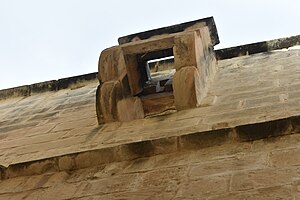Machicolation
| Machicolation | |
|---|---|
Mâchicoulis, Piombatoio | |
 A box-machicolation of the Tal-Wejter Tower, in Birkirkara, Malta[1] | |
| General information | |
| Location | Europe, Middle East and North Africa |
| Technical details | |
| Material | Stone, sometimes wood |
A machicolation (French: mâchicoulis) is a floor opening between the supporting corbels of a battlement, through which stones or other material, such as boiling water, hot sand, quicklime[2] or boiling cooking oil, could be dropped on attackers at the base of a defensive wall.[3] A smaller version found on smaller structures is called a box-machicolation.
Terminology


The structures are thought to have originated as Crusader imitations of mashrabiya.[4]
The word derives from the
Both the Spanish and Portuguese words denoting this structure (matacán and mata-cães, respectively), are similarly composed from "matar canes" meaning roughly "killing dogs", the latter word being a slur referring to infidels.[7][page needed]
In Italy and countries which were influenced by the Italian language, such as Malta, it was known as piombatoio.[8]
Similar to a machicolation is a smaller version which opens similar to an enclosed balcony, generally from a tower rather than a larger structure. This is called a box-machicolation.[9]
Description and use


The design of a machicoulis (sometimes called drop box) originates from the Middle East, where they are usually found on defensive walls. The original Arabian design is rather small, and similar to the domestic wooden balcony known as mashrabiya.[10]
In contrast to the domestic balcony, the Middle-East version of the machicoulis prominently features a wide opening at the bottom for defensive purposes. The opening allows the dropping of hot water and other material intended to cause harm to the enemy below. The otherwise enclosed opening adapted from that of a closed balcony also provides cover from enemy attack while using it.[10][4]
Machicolations were more common in French castles than English, where they were usually restricted to the gateway, as in the 13th-century Conwy Castle.[11] One of the first examples of machicolation that still exists in northern France is at the Château de Farcheville built in 1291 outside Paris.[12]
The origins are from
A
Post-medieval use

Machicolation was later used for decorative effect with spaces between the
See also
- Arrow slit
- Bartizan
- Battlement
- Bretèche
- Defensive walls
- Jettying
- Murder hole
- Hoarding (castle)
Notes
- ^ For example, Scottish baronial architecture from the 16th century onwards; and Neo-Gothic buildings of the 19th and 20th centuries.
References
- ISBN 9781787383050.
- ^ Medieval castle SIEGES in depth
- ^ Jaccarini, C. J. (2002). "Il-Muxrabija: Wirt l-Izlam fil-Gzejjer Maltin" (PDF). L-Imnara (in Maltese). 7 (1). Ghaqda Maltija tal-Folklor: 17–22.
- ^ ISSN 1026-132X. Archived from the original(PDF) on 15 November 2015.
- ISBN 2-03-340-302-5.
- ^ Hoad (1986) p. ?.
- ^ Villena (1988) p. ?.
- ^ a b Spiteri, Stephen C. (2008). "Naxxar and its Fortifications" (PDF). Arx - Online Journal of Military Architecture and Fortification (1–4): 13. Archived from the original (PDF) on 21 May 2017.
- ^ a b Spiteri, Stephen C. (May 2008). "A Medieval tower at Qrendi?" (PDF). Arx - Online Journal of Military Architecture and Fortification (6): 59. Archived from the original (PDF) on 26 November 2016.
- ^ a b Jaccarini, C. J. (2002). "Il-Muxrabija, wirt l-Iżlam fil-Gżejjer Maltin" (PDF). L-Imnara (in Maltese). 7 (1). Rivista tal-Għaqda Maltija tal-Folklor: 19. Archived from the original (PDF) on 18 April 2016.
- ^ Brown (2004), p. 66.
- ISBN 2-08-012271-1.
- ISBN 0-918400-08-2.
- ISBN 9781844153589. (1st ed. 1955; 2nd ed. 1966)
- ISBN 9780195334036.
Bibliography
- Brown, R. Allen (2004) [1954]. Allen Brown's English Castles. Woodbridge: The Boydell Press. ISBN 1-84383-069-8.
- Hoad, T. F. (1986), English Etymology, Oxford University Press
- Villena, Leonardo (1988). "Sobre las defensas verticales en España: tipología y terminlogía comparadas". In Andrés Bazzana (ed.). Guerre, fortification et habitat dans le monde méditerranéen au Moyen Age: colloque. Casa de Velázquez. ISBN 978-84-86839-02-4.
